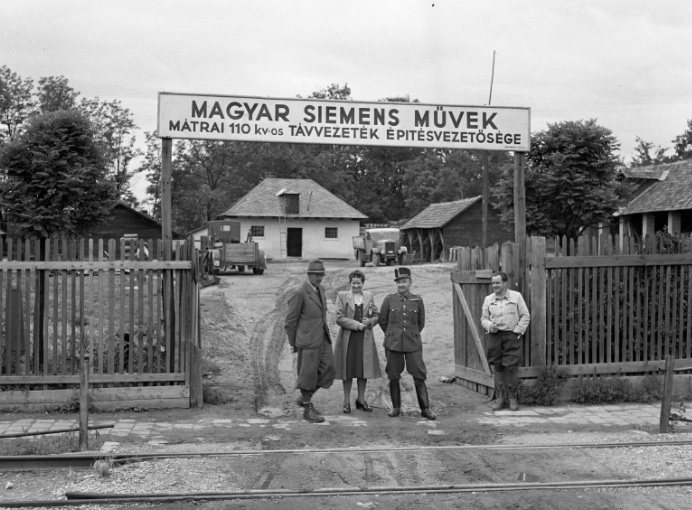The historian Zsuzsanna Borvendég's series was originally published on the PestiSrácok website, but there are certainly those who missed it. But those who haven't read all the parts should also read it again. Knowing the whole picture, can we understand how we got here?
By the end of the 1960s, computing became the cornerstone of technology development: in the Eastern Bloc, they began to develop a common concept with the aim of coordinating the work of scientists from the "sister states". Of course, the OMFB also played a prominent role in the fulfillment of the tasks assigned to Hungary, and the advisory board was indispensable when arranging procurements and concluding cooperation contracts. The goal of the coordinated work that started in 1967 was to develop a mutually compatible computer family, the Unified Computing System (ESZR).
10125/1968 in Hungary. government decision no. provided for the establishment of the IT Interministerial Committee, which was responsible for developing the development program and created and monitored the license purchase policy. The top leaders of the committee included Árpád Kiss , the president of the OMFB, Zsolt Náray , who was the chief designer of the unified computer system, and János Sebestyén .
In order to create the Unified Computing System, the Hungarian side had to create the smallest member of the computer family to be developed, which was later a significant advantage for the company Videoton, which carried out the development and production, since they could more easily move towards the world of mini and microcomputers. The implementation was planned for seven years, between 1969 and 1975, during which they wanted to reach the level of computer technology of the moderately developed European capitalist countries; the costs were estimated at roughly ten billion forints.
Vidipex has started
It should be emphasized separately that Videoton was only willing to undertake the large-scale work on the condition that it could work with Western technology, which is why it received the foreign trade right, since it was able to solve the procurement of embargoed products more effectively directly than by interposing an impex. Thanks to this, Vidipex was created, which later became one of the key bases for the computer technology purchases of the Soviet bloc - considerable sums could flow from the Hungarian economy through it - with leaders such as Apró Piroska .

Checking televisions at Videoton (photo: Fortepan)
The financial framework for the developments was significant enough to attract the interest of foreign suppliers. By outbidding each other, they tried to make advantageous offers for Hungary, but they could not break the positional advantage of Siemens, despite the fact that the West German concern was less competitive in the field of computer technology. The Hungarian user companies were clearly on IBM's side, since the American company had been present in our country since the 1930s and had a representative office in Budapest, even after the nationalizations. -maintenance works, and even simpler parts, if applicable, were able to be produced, thus mitigating the effect of the embargo.
Until the 1960s, IBM had little competition, Hungary also used their machines even in sensitive areas such as the Ministry of the Interior or the Central Statistical Office. In the 1960s, however, there was an opportunity to break IBM's dominance, which could also be supported on ideological grounds, since the Communist Party leadership did not have to argue much about the rise of American imperialism or the obstruction of the CIA's information acquisition.
The Sebestyenes chose Siemens
Sebestyén and his circle definitely wanted to buy the computers of Siemens, which were not very fast and operated with little efficiency, arguing that in this way we could become independent from American technology. (In the meantime, they wisely kept quiet about the fact that European computers are also based on American developments and components.) The offers of Siemens, which were inferior in both price and value competition, were supported by almost no one except the OMFB, so with the help of the Ministry of Foreign Trade (KKM) the Sebestyéns managed to completely they exclude people with disabilities from procurement.
The scientific committee could not make purchases directly, for that it had to use the work of foreign trade companies with a monopoly, which, however, covered one segment of the market by sector, i.e. different companies had to be commissioned to purchase different types of products. This was difficult, and it was not possible to involve all impex managers equally in Sebestyén's sphere of interest, so they selected a company that did all the imports of OMFB, regardless of whether the product fit the company's profile or not. Transelektro became a partner of the OMFB, whose leader at the time Mihály Farkas (only a namesake of Rákosi's Minister of National Defense), an officer of the MNVK-2, or military intelligence. In 1968, Farkas was stationed in Paris for a while - he was entrusted with the management of the commercial branch there - but after his return, he became the director of Sicontact, the Siemens representation in Budapest that was to be established.

image: Fortepan
János Nyerges and Transelektro
The OMFB was not obliged to ask for counter-offers during its business deals, or at least, referring to a "letter" from the KKM dated 1966, it concluded contracts with the partner it selected practically without competition. The designation "letter" does not appear to be an official permit, moreover, according to the state security's comment, it was signed by a department head, yet the internal affairs officers did not have the courage to question the document's validity.
In the KKM, Sebestyén had several supporters, but the most powerful of them was the previously mentioned gray eminence, János Nyerges .
With the administrative help of the ministry and the reliable employees of Transelektro, Sebestyén and his circle appropriated the area of IT procurement. A group was created within the foreign trade company to deal only with OMFB matters. Its leader Károlyn Jelinek , whose reliability and conspiracy practices were long ago convinced by those involved, as she was previously Gábor Péter . Mrs. Jelinek's operation at the company had already attracted the attention of the police; to their knowledge, he was involved in many activities where suspicions of economic abuse arose, but he was never investigated because he was supported in high party circles.
Her daughter's father-in-law János Borbándi , who in the early seventies, when the abuses of the OMFB were being investigated, held the position of head of the Administrative Department of the MSZMP KB and was a member of the narrower defense cabinet of the Council of Ministers, the National Defense Committee, and from 1974 he was also chairman as deputy prime minister .
People from the outsourcing network were everywhere
It is therefore a multi-threaded story, of which I have only presented a small part so far, but it can already be seen from this that the members of this mafia-like network were present in the party leadership, the secret service, foreign trade, the management of scientific developments and the ministerial apparatus. According to the state security, they caused serious damage to the country by accepting the often clearly unfavorable offers without competition.
In principle, the computer technology purchases would have belonged to the Metrimpex company, but Transelektro ran through their calculations. Metrimpex conducted serious negotiations with the English company Honeywell, taking advantage of the great Western interest in the Eastern computer technology development program, and obtained a thirty percent discount from them. This also had a serious impact on the Siemens purchases, as the West German company did not want to cede its positions in Hungary to the English, so they were willing to give the same price discount.
Metrimpex, which obtained a better offer, was kicked out
According to counter-espionage information, Metrimpex's success in the United Kingdom was cited as a deterrent example, referring to the fact that the Hungarian party considered Honeywell's discount as a starting point from then on and insisted on these conditions during its further purchases.
The interest group organized around Sebestyén did not look favorably on Metrimpex's success, as it would have taken the management and supervision of IT purchases out of their hands. One of Sebestyén's men, Simon Endre (they knew each other even from Frankfurt, and later Simon, as an official of the KKM, facilitated the development of the engineer's corrupt business circle, and later became his subordinate at the OMFB) managed to remove Metrimpex's businessmen, who had recovered quite a bit, from the formula. Simon stated that " he is not willing to work with Metrimpex, because it constantly wants to squeeze discounts from the foreigner, and with this, on the one hand, it discourages cooperation, and on the other hand, it drags out the time with the negotiations and thus makes delivery by the requested deadline uncertain".
Yes, they understood correctly: the offer negotiated by Metrimpex was not good because they managed to get too big discounts. In the end, the country would have done well and not the foreign mafia.
The stakes were high, a fierce struggle for Siemens' market dominance began even within the party ranks, to which we can even associate political murders.
Source: PestiSrácok
Author: historian Zsuzsanna Borvendég
(Cover photo: Videoton Venice de Lux radio. Photo: Galéria Savaria)













